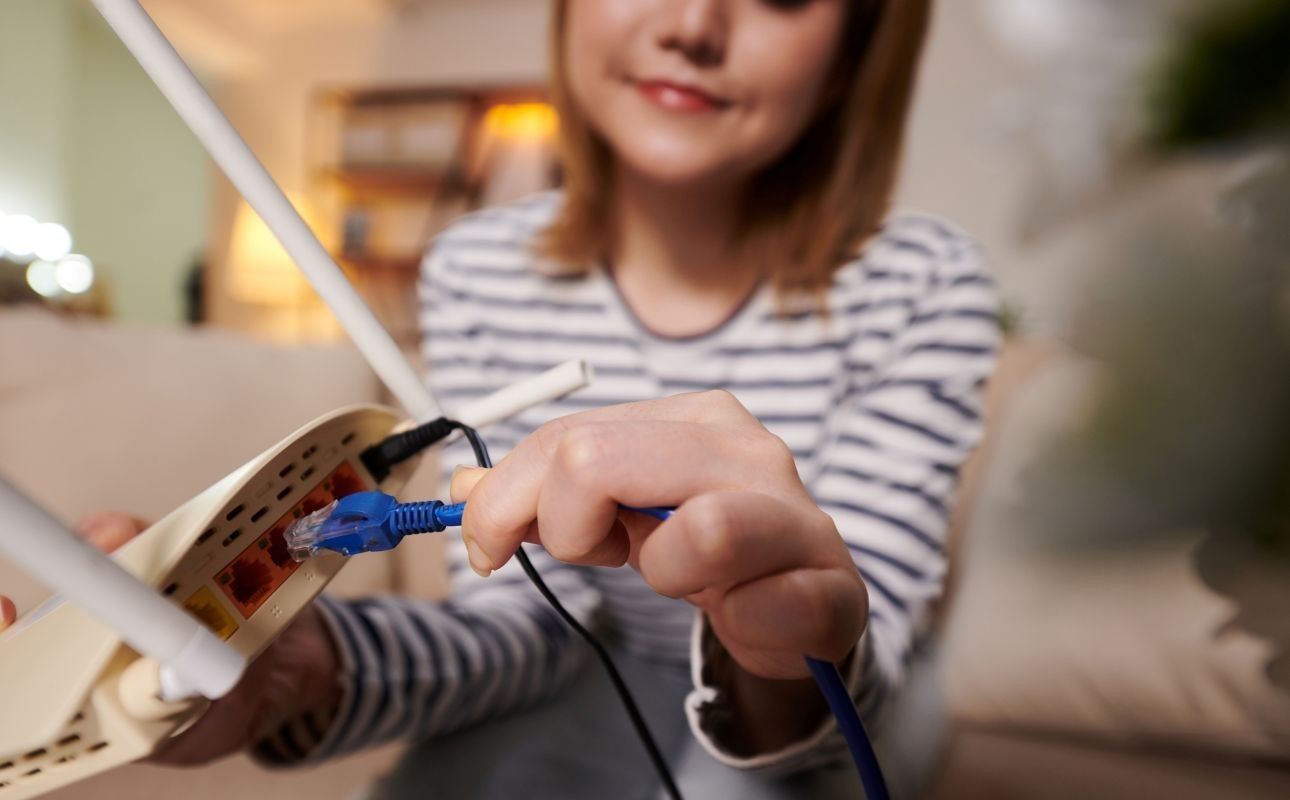What VoIP devices do you need for VoIP phone service?

VoIP, or Voice over Internet Protocol, allows you to make phone calls using your internet connection instead of relying on traditional phone lines. With benefits like lower costs, advanced features and enhanced flexibility, VoIP has become a popular choice for anyone looking to modernize their phone systems.
The best part? Setting up VoIP phone service is simpler and more affordable than you might think. Most homes already have everything you need except for an adapter, making the transition a breeze. So, if you’re curious about making the switch but are wondering if you need any special equipment like a VoIP device, keep reading. We’re breaking it all down for you.
Understanding VoIP phone service
Unlike traditional phone systems that rely on copper lines, VoIP converts your voice into digital data, allowing it to travel over the internet to its destination.
With VoIP, you can enjoy a host of benefits. For one, cost savings are a major advantage. With lower infrastructure and maintenance costs, VoIP phone plans often have budget-friendly calling plans compared to traditional phone systems, especially for long-distance and international calls.
Beyond cost savings, VoIP enables advanced features that enhance communication. Call forwarding, voicemail-to-email and text alerts when someone in your home calls 911 are just a few examples of the feature-rich capabilities that VoIP can offer.
Flexibility is another highlight of VoIP. You can make and receive calls from any device connected to the internet, whether it’s a standard phone or your smartphone, allowing you to move freely between locations while staying seamlessly connected.
To top it off, switching to VoIP is a simple process. The setup is hassle-free, and no complex equipment is needed. All that’s required is an internet connection, which is enabled by your modem and router, and an adapter that can handle VoIP calls.
Let’s take a closer look at each requirement.
What are the internet connection requirements for VoIP calling?
Having a stable internet connection is crucial for smooth VoIP phone service. Since VoIP relies on the internet to transmit calls, a reliable connection helps ensure crystal-clear conversations without disruptions. It’s worth noting, though, that VoIP doesn’t require a super-fast connection. Most modern internet plans easily meet the basic requirements for seamless VoIP communication.
What equipment do you need for an internet connection?
To get your home connected to the internet, you’ll need two essential pieces of equipment: a modem and a router. In many cases, your internet service provider (ISP) will provide you with a gateway, which is a single device that serves as both a modem and a router.
A modem is a device that connects your home to your Internet Service Provider (ISP) either wirelessly or through coaxial cables, phone lines or other types of wiring. It converts the incoming digital data from your ISP into data that your devices can understand and vice versa. It’s like the entry gate to the internet, establishing the initial communication.
Once your modem brings the internet to your household, a router takes the reins. It moves the data from the modem and distributes it among your devices, like your laptop or smart TV. Routers also provide local IP addresses to devices, making sure data arrives at the right destination within your home network.
In the context of routers, you want one that has Quality of Service (QoS) settings, which enables you to prioritize certain types of internet traffic over others. When it comes to VoIP, QoS is crucial. It ensures that your VoIP calls get the bandwidth they need, preventing call drops and ensuring crystal-clear conversations. With QoS, you won’t have to worry about your roommate’s Netflix binge slowing down your important business call, for instance.
As mentioned, many ISPs offer a combined modem-router unit known as a gateway. Gateways streamline setup by eliminating the need for two separate devices. They efficiently manage both your internet connection and data distribution, simplifying your networking needs.
What is the minimum required internet speed for VoIP?
According to the FCC, VoIP calls require a minimum download speed of less than 0.5 Mbps. This is very low and most modern internet plans easily meet this requirement.
For comparison, using social media requires a speed of 1 Mbps and streaming standard definition video requires a minimum of 3-4 Mbps. In other words, if you have no trouble visiting Instagram or watching Netflix on your internet plan, then there’s a good chance your internet connection can handle VoIP calls.
In some cases, VoIP providers will have specific internet speed requirements for their particular service. For example, Ooma’s home phone service recommends connections of at least 0.384 Mbps for both upload and download.
You can easily check your current internet speed online. Make sure to run the test at different times of the day to get a good idea of your connection’s consistency. If your connection meets or exceeds the recommended minimums, you’re good to go.
What equipment do I need to make VoIP calls?
Besides an internet connection, you’ll need your existing phone set and a VoIP device known as an analog phone adapter (ATA) to make VoIP calls. You can also typically make calls on your mobile phone by downloading a mobile app—that’s if your provider is like Ooma and offers this handy feature. Let’s explore each of these in detail.
Traditional analog phone
Chances are, you already have a trusty old analog phone sitting at home. The good news? You don’t have to part ways with it when you transition to VoIP. Your tried-and-true phone can seamlessly transition to the world of internet-based calling with the help of an analog telephone adapter (ATA).
Using your existing analog phone with VoIP offers multiple perks. First, it saves you the expense of purchasing a new phone. Plus, there’s no learning curve–you’ll be making calls like a pro without having to adapt to a brand-new device.
Now, you might be wondering, why can’t you just directly plug your analog phone into the internet and start making VoIP calls? Well, it’s a bit like trying to fit a square peg into a round hole.
Your traditional landline phone is designed to convert your voice into analog signals that are sent over copper lines. Meanwhile, VoIP uses digital signals to transmit calls over the internet. That’s where an analog telephone adapter comes in, acting as a translator between your analog phone and VoIP system. Keep reading to learn more about ATAs.
What is an ATA device for VoIP?
An analog telephone adapter (ATA) acts as the bridge between your traditional analog phone and the digital VoIP network. It’s a small, easy-to-install device that converts the analog signals from your phone into digital data that can be transmitted over the internet. It’s the only VoIP device you’ll need.
In general, here’s how it works: Simply plug your analog phone into the ATA, and then connect the ATA to your internet network. The ATA will handle the signal conversion, allowing you to make and receive VoIP calls with your existing phone.
The details of how an ATA connects to your internet may vary depending on your service provider. Most ATAs connect directly to your internet router via an Ethernet cable. Some, like Ooma Telo Air, remove the hassle of cables by connecting to your Wi-Fi® network instead.
To sum it up, an ATA is an important piece of equipment that connects your existing phones to the internet and allows you to enjoy the cost-saving benefits and feature-rich experience of VoIP.
Mobile app (softphone)
With the rise of smartphones and tablets, the convenience of turning your mobile device into a VoIP phone has become a game-changer. Many VoIP service providers offer a software solution for staying connected on the go—mobile apps that transform your smartphones or tablets into fully functional VoIP phones, or “softphones.”
With a download of a mobile app provided by your VoIP service, you can make and receive calls on your existing devices from anywhere you have an internet connection. Whether you’re on a business trip or lounging at home, your smartphone can double as your VoIP phone.
Softphones generally offer the same features as traditional VoIP phones, ensuring you don’t miss out on any calls. Plus, they often have a friendly user interface that makes it easy to manage your account and access voicemails on your mobile device.
Optional accessories to consider
Besides the essential equipment mentioned above, there are also optional accessories that can add convenience and functionality to your setup.
- Headphones or earbuds. Connect them to your mobile phone for a convenient, hands-free experience when you use your softphone on the go.
- Battery Backup. Enjoy uninterrupted VoIP service even during power outages with a battery backup solution, ensuring you’re well-connected for any essential communications like 911 calls.
- LTE Adapter. If internet service is unavailable, unreliable or too expensive in your area, an LTE adapter can be used to enable VoIP service via a high-speed LTE connection. It can also be used as a backup in the case of an internet outage.
- Call recording devices. Many VoIP providers offer call recording features but, if your provider doesn’t, having a dedicated call recording device can be valuable for record-keeping purposes.
Remember, while these accessories can enhance your VoIP experience, they are not essential for getting started. Feel free to explore these options based on your specific needs and preferences. Whether it’s optimizing productivity or adding flexibility to your communication, these accessories can elevate your VoIP phone service to the next level.
Checking VoIP service compatibility
Ready to upgrade to a VoIP phone system? Here’s a quick guide to help you determine if you’re all set to make the switch.
1. Check your internet speed. Begin by testing your internet speed. For a smooth VoIP experience, you’ll generally need a reliable broadband connection with sufficient upload and download speeds. Look for speeds of at least 0.5 Mbps in both directions.2. Verify modem capabilities. Check whether your modem can handle VoIP traffic efficiently. Some ISPs provide modems that are optimized for VoIP services. If you’re unsure, contact your internet service provider for clarification.3. Assess your router. Confirm that your router supports Quality of Service (QoS) settings, which prioritize VoIP traffic for better call quality. If your router doesn’t have this feature, consider upgrading to one that does.4. Confirm phone compatibility. If you plan to use traditional phones with an ATA, ensure they are in working condition. For IP phones or mobile apps, check that your devices are compatible with the VoIP service provider’s requirements.5. Reach out to your VoIP provider. If you have any specific concerns or questions about compatibility, don’t hesitate to contact your chosen VoIP service provider. They will be most equipped to assist you and guide you through any necessary adjustments.Remember, the transition to VoIP should be seamless and hassle-free. By ensuring compatibility beforehand, you’ll be set up for a smooth and enjoyable VoIP phone service experience.
Make the switch to VoIP for free* with Ooma Basic
With Ooma® home phone service, you can enjoy clear residential phone service for free*—just pay applicable taxes and fees. Calculate your savings here.
Or elevate your experience with advanced features by upgrading to Ooma Premier for only $9.99 per month, plus applicable taxes and fees.
Ready to take the leap? Give us a call today at (877) 345-8852 and our experts will be happy to answer your questions.



